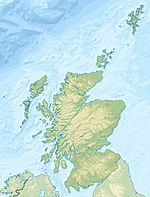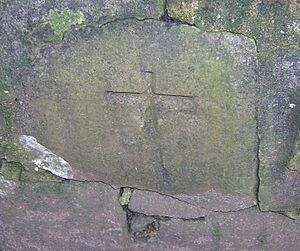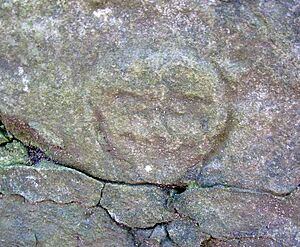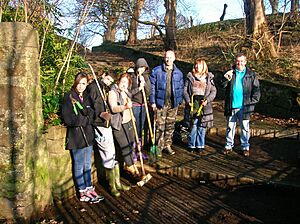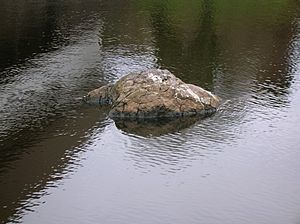The Chapel Well facts for kids
The Chapel Well, also known as Saint Mary's Well, is a special spring located next to the River Irvine in Irvine, Scotland. You can find it at the end of a path called Chapel Lane, which connects to Kirk Vennel. Some people mistakenly call it 'Saint Inan's Well'.
Contents
What the Chapel Well Looks Like
The Chapel Well is a spring built into the wall of Chapel Lane. Above the well, there's a stone plaque that says 'St Inan's Well AD 839'. The well itself is quite shallow and shaped like a half-circle, with a stone roof and base. Water gently seeps into the well from the rocks behind it.
People sometimes use the well as a wishing well, throwing coins in for good luck. The well is about 85 cm (about 33 inches) wide at the front and 100 cm (about 39 inches) wide inside. It's 90 cm (about 35 inches) deep, and the water is usually about 50 cm (about 20 inches) deep.
The wall near the well is much taller than other parts, almost like an old building end. Maps show that the land above the well used to be part of a church's land (called a glebe) and then golf fields, before a house for a minister (a manse) was built there. You can also find plants like bluebells nearby, which often grow in very old woodlands.
History of the Chapel Well
The Well's Many Names
This well is officially known as 'Chapel Well' but is also called 'St Mary's Well'. It's thought to be very close to where an old chapel dedicated to Saint Mary once stood. The stone plaque saying 'St Inan's Well AD 839' was put there by the Irvine Burns Club.
In the 1700s, people used the well to wash clothes. Later, in the 1830s, when there was a health concern in Irvine, the Chapel Well was considered the best source for clean drinking water.
In 1763, the local council bought the land where the chapel and well were located. The purchase included a small wash house near the well.
While the plaque mentions Saint Inan, this might be a mistake. Saint Inan is linked to Irvine, and there was once a well named after him in Fullarton, south of the harbour. The well was covered with concrete in 1954.
In 2013, the well area was cleaned up and improved by a local group called the Redburn Activity Agreement Group, working with the North Ayrshire Ranger Service. On September 25, 2013, a special ceremony was held to re-dedicate the well, with local school children and community members attending.
Saint Mary's Chapel
Long ago, before the Reformation (a big change in the church), there was a chapel dedicated to the Virgin Mary near the River Irvine, below the current churchyard. Records show a grant was given to it in 1471-72. Parts of the chapel's old walls have been found, though nothing remains visible today. The fact that the nearby well is called Chapel Well supports the idea that a chapel dedicated to St. Mary was once here.
We don't know exactly when the chapel was built, but it might have been even older than the early Irvine church. Both the church and the chapel existed at the same time in the 1400s, and they both received money from the same gift in 1446.
When the land near the chapel was bought by the Town Council in 1761, digging revealed old wall foundations, which were likely from the chapel.
Carvings Near the Well
In recent times, five stones with carved crosses were found in the wall near the Chapel Well. However, one is now gone, and two others are buried underground. These crosses might have been used as markers to show the boundaries of church land, but they could also be connected to the old chapel. There's also a carved face and some other faint markings on two other stones nearby.
The Grannie Stane
A large stone called the Grannie Stane is located a short distance from the Chapel Well in the River Irvine. This stone is either a glacial erratic (a large rock left behind by a glacier during the Ice Age) or it's the last stone from an ancient stone circle. Other stones from the circle were removed by blasting in the late 1800s, but people protested and saved this one. It's interesting that the chapel and well are so close to where a stone circle might have been, as it was common for Christian sites to be built near older, non-Christian sacred places.
Chapelford
In 1895, a weir (a small dam) was built, which raised the water level of the river. This caused the old Chapelford, a place where people used to cross the river, to be lost underwater.
Other Interesting Facts
The foundations of the old chapel were disturbed when the Riverside Walkway was being built in the 1980s. There used to be a small jetty nearby where boats could tie up, and a path with steps led through the woods.
See also


